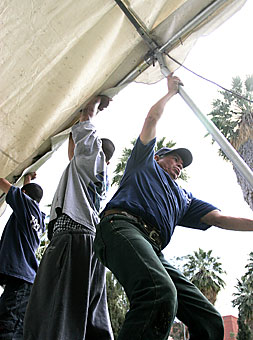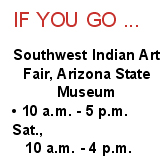 |
|
JAKE LACEY/Arizona Daily Wildcat
|
Workers from Parties Plus set up a tent on the Mall in front of the Arizona State Museum yesterday for the upcoming art fair this weekend.
|
|
|
By Monica Warren
Arizona Daily Wildcat
Friday, February 25, 2005
Print this
More than 200 American Indian artists and an estimated 6,000 art lovers will descend on the Arizona State Museum this weekend for the 11th annual Southwest Indian Art Fair.
American Indian artists from throughout the Southwest will be selling their crafts, which include jewelry, pottery and paintings.
For the first time, UA students will receive free admission when they present their CatCard at the fair, which will run Saturday from 10 a.m. to 5 p.m. and Sunday from 10 a.m. to 4 p.m. on the lawn in front of the museum.

If You Go...
|
|
In addition to the artwork, fair attendees will be able to observe a number of demonstrations and performances. This year, Navajo weaving and flute making, Hopi kachina doll carving and Tohono O'Odham basket weaving will be on display.
A number of musicians, dancers and storytellers will entertain and educate the crowds both days.
Sherri Raskin, program coordinator for the museum, said the advantage of the art fair is the ability to interact with the artists and talk to them about their work. She also said buyers can be
confident that what they are buying is original and handmade.
"People know what they're buying here is quality," Raskin said. "Nothing you'll buy here is made in China."
Raskin said many UA students, especially those who are from different regions of the country, don't know much about the culture of the Southwest's indigenous groups.
She encouraged students to attend the fair to "experience the diversity of different tribal groups in our area. It's fun and it won't cost anything."
Kassondra Yaiva, a nutritional sciences senior, is a member of the Hopi tribe. Last year she attended the art fair and performed traditional Hopi social dances with a dance group. In addition to dance, Yaiva creates other traditional tribal art including quilts.
Yaiva said many of the same artists return to the fair year after year, which is an advantage to fair attendees and the community.
"It's interesting to be in that atmosphere," she said. "It brings a whole wide variety of cultures that can be shared among Tucsonans."
Yaiva said the new free admission policy will give students a chance to learn about the art and culture, but also to have a good time.
"If you don't buy, at least look and enjoy the day," Yaiva said.
